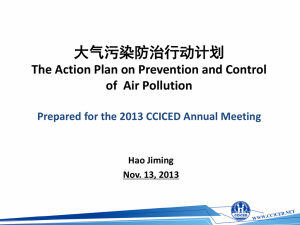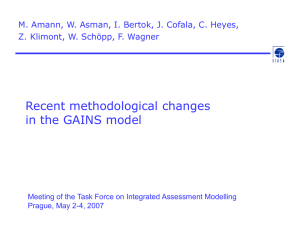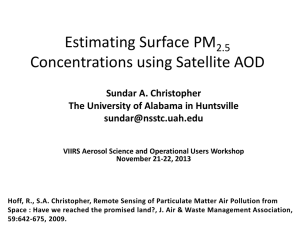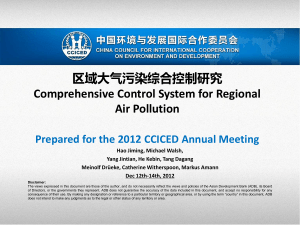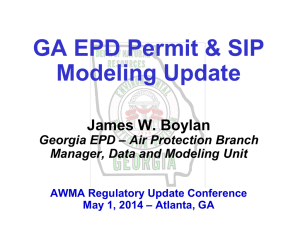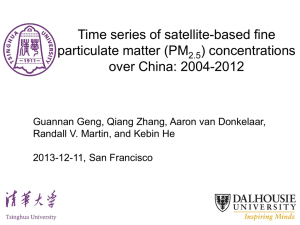R NOx - CMAS
advertisement
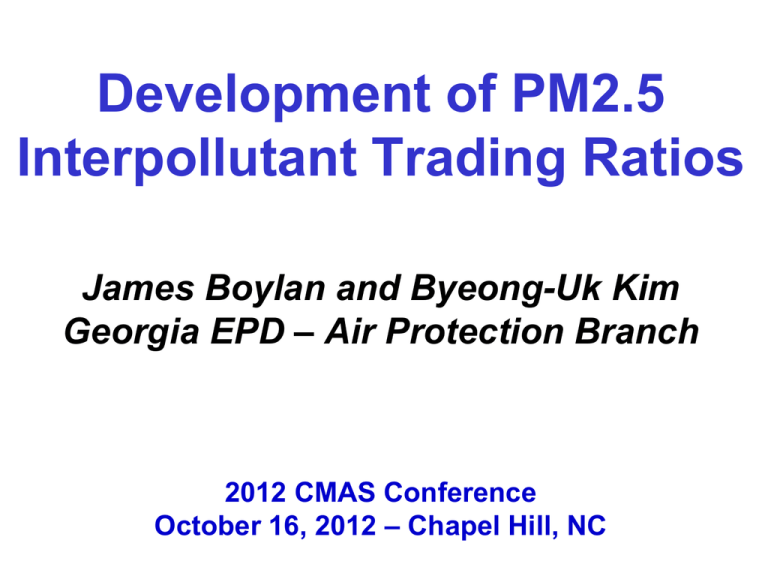
Development of PM2.5 Interpollutant Trading Ratios James Boylan and Byeong-Uk Kim Georgia EPD – Air Protection Branch 2012 CMAS Conference October 16, 2012 – Chapel Hill, NC Introduction • Sources applying for permits in areas designated nonattainment for PM2.5 can offset emissions increases of direct PM2.5 emissions or PM2.5 precursors with reductions of either direct PM2.5 emissions or PM2.5 precursors in accordance with offset ratios contained in the approved SIP for the applicable nonattainment area. – An existing source can increases PM2.5 emissions by X tons in exchange for reducing SO2 emissions by Y tons. • PM2.5 offset ratios can be used to account for secondary formation of PM2.5 in a dispersion model – NACAA PM2.5 Secondary Formation Workgroup 73 Fed. Reg. 28339 (05/16/08) • EPA developed default PM2.5 offset ratios • SO2 to Primary PM2.5 • 40:1 (SO2 tons for PM2.5 tons) nationwide. • NOx to Primary PM2.5 • 200:1 (NOx tons for PM2.5 tons) in the eastern United States. • 100:1 (NOx tons for PM2.5 tons) in the western United States. EPA Memo – July 21, 2011 • “We will no longer consider the preferred ratios set forth in the preamble to the 2008 final rule for PM2.5 NSR implementation to be presumptively approvable. Instead, any ratio involving PM2.5 precursors adopted by the state for use in the interpollutant offset program for PM2.5 nonattainment areas must be accompanied by a technical demonstration that shows the net air quality benefits of such ratio for the PM2.5 nonattainment area in which it will be applied.” EPA Memo – July 21, 2011 • The general framework for such developmental efforts would include the following steps: 1) Define the geographic area(s). 2) Conduct a series of sensitivity runs with appropriate air quality models to develop a database of modeled PM2.5 concentration changes associated with reductions of direct PM2.5 emissions and PM2.5 precursor emissions. 3) Calculate the interpollutant offset ratios for PM2.5. 4) Conduct quality assurance of the resulting ratios. PM2.5 Offset Ratios • Normalized Sensitivity (S) – SSO2 = (DPM2.5SO2/DTPYSO2) – SNOx = (DPM2.5NOx/DTPYNOx) – SPM2.5 =(DPM2.5PM2.5/DTPYPM2.5) •PM2.5 Offset Ratios (R) – RSO2 = SPM2.5/SSO2 – RNOx = SPM2.5/SNOx PM2.5 Offset Ratios • Do they vary with distance from the source? • Do they vary with season of the year? • Do they vary with grid resolution? • Do they vary by stack height? • Do they vary by emission rates? • Do they vary by region within a state? Case Study: Georgia • Plant Washington – 850 MW Coal Fired Power Plant located in Washington County, GA • Final permit issued on April 8, 2010 • GA EPD used CAMx modeling to account for secondary PM2.5 impacts and ozone impacts from the proposed facility. Model Setup • MM5 for Meteorology – VISTAS 2002 • SMOKE for Emissions – VISTAS 2009 used in Georgia PM2.5 SIP – Added power plant emissions • 4200 TPY SO2, 1817 TPY NOx, 6 TPY EC • CAMx with Flexi-nesting – 12-km/4-km/1.333-km • Three sensitivity runs to calculate baseline PM2.5 offset ratios – Zero-out stack emissions: SO2, NOx, EC CAMx Modeling Domains CAMx 12 km CAMx 4 km CAMx 1.3 km AERMOD D PM2.5 – Annual EC and SO2 D PM2.5 – Annual EC and NOx Annual DPM2.5 Annual Sensitivity (DPM2.5/DE) Annual PM2.5 Offset Ratios Quarterly SO2 Offset Ratios (DPM2.5PM2.5/DTPYPM2.5) RSO2 = --------------------------------(DPM2.5SO2/DTPYSO2) Quarterly NOx Offset Ratios (DPM2.5PM2.5/DTPYPM2.5) RNOx = --------------------------------(DPM2.5NOx/DTPYNOx) RSO2 vs. Grid Resolution RNOx vs. Grid Resolution RSO2 vs. Stack Height RNOx vs. Stack Height SPM2.5 vs. Stack Height SSO2 vs. Stack Height SNOx vs. Stack Height RSO2 vs. Emission Rate RNOx vs. Emission Rate SPM2.5 vs. Emission Rate SSO2 vs. Emission Rate SNOx vs. Emission Rate Summary • PM2.5 offset ratios vary with distance. – Maximum ratio is always near the source. • PM2.5 offset ratios vary with season. – Can use seasonal ratio for daily PM2.5 ratio. • PM2.5 offset ratios vary with grid resolution. – Need 4-km grid resolution (or less) to evaluate near source impacts, 12-km sufficient for more distant impacts. • PM2.5 offset ratios vary with stack height. – Impacts of meteorology and chemistry are important near the source. • PM2.5 offset ratios vary with emission rate. – Direct PM2.5 is linear, but SO2 and NOx are nonlinear near the source. Ratios for Plant Washington • SO2 to Primary PM2.5 – 40:1 for annual NAAQS (near source) – 10:1 for annual NAAQS (far from source) – 25:1 for daily NAAQS (Q3 - near source) – 5:1 for daily NAAQS (Q3 - far from source) • NOx to Primary PM2.5 – 85:1 for annual NAAQS (near source) – 40:1 for annual NAAQS (far from source) – 60:1 for daily NAAQS (Q3 - near source) – 20:1 for daily NAAQS (Q3 - far from source) Policy Issues • Should we use the “near source” ratios or the “far from source” ratios? – Does it depend on the location of the sources that are trading and/or the location of the maximum PM2.5 concentrations in the area? • Can you use the “most conservative” SO2 and NOx trading ratios for other sources in region? – Depends if source is trading SO2/NOx for PM2.5 or trading PM2.5 for SO2/NOx. • Increase PM2.5 emissions by 1 ton in exchange for reducing SO2 emissions by 40 tons (40:1 ratio). • Increase SO2 emissions by 10 tons in exchange for reducing PM2.5 emissions by 1 ton (10:1 ratio). Contact Information Jim Boylan, Ph.D. Georgia Dept. of Natural Resources 4244 International Parkway, Suite 120 Atlanta, GA 30354 James.Boylan@dnr.state.ga.us 404-362-4851


